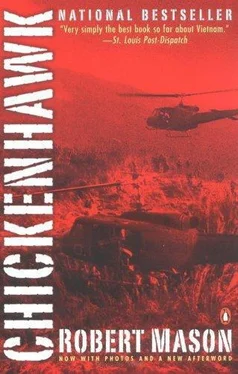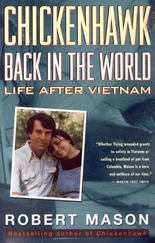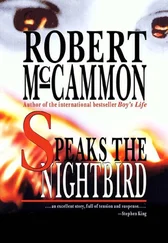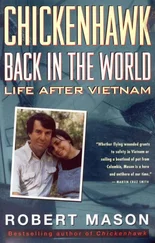I overcontrolled the pedals, making the tail wag back and forth. This was a common reaction to the sensitive controls and was called the “Huey shuffle.”
The heavy, thudding noise of the main rotors—the characteristic wop-wop-wop sound—was caused by their huge size, 48 feet from tip to tip, and a 21-inch chord (width). With ballast weights at each blade tip, the whirling rotor system had tremendous inertia. The IP demonstrated this inertia with a trick that only a Huey could do. On the ground at normal rotor speed (330 rpm) he cut the power, picked the machine up to a four-foot hover, turned completely around, and set it back on the ground. Incredible! Any other helicopter would just sit there, not rising an inch, while the rotors slowed down. These big metal blades with the weights in the tips would serve me well in Vietnam. Their strength and inertia allowed them to chop small tree branches with ease.
During this orientation period in the Huey, Patience drilled me at home on the checklist. Her method was negative reinforcement. She kicked me in the shins at each mistake. I learned it so well that even now, when I recall the Huey cockpit check, I get a twinge in my leg.
Flying an hour each day, it took two weeks to finish the orientation in the Huey. Next was instrument flying.
We were one of the first classes to get instrument training. Helicopter pilots traditionally maintained eye contact with the ground. To the old pilots, VFR (visual flight rules) and IFR (instrument flight rules) were one and the same: “visually follow roads” and “I follow roads.” If a storm got bad, you just flew slower and lower. If it got real bad, you stopped in a field. That innocent philosophy was coming to an end. The helicopter was going to war; in war you can’t fly slower and lower or stop just because the weather is bad.
I enjoyed the instrument training very much. You got into a Huey with an instructor, put on the hood (a device which restricted your vision to inside the cockpit), flew all over Alabama, making practice landings at airports you never saw, and returned an hour or two later, never having seen the ground or the sky or anything except the inside of the cockpit. On my final check ride I flew from Fort Rucker down to Gainesville, Florida, and back, making four approaches to strange airfields and two course intersections. The dreamlike flight lasted four hours. The only clues that I was flying were moving needles in gauges and radio conversations with various control towers. I had to use this training only a few times in Vietnam, but it saved lives when I did.
On May 11, 1965, we got our warrant-officer bars and our silver wings. My father and sister and Patience and Jack were there to see me graduate. (My mother was sick, and couldn’t attend.) I was very proud. It had been the most eventful ten months of my twenty-three years.
———
Sixty percent of our class were sent immediately to Vietnam. I was among the forty percent who thought they had somehow lucked out by getting assignments in the States. This was an illusion. I had asked for and been assigned to the 3rd Transportation Company, Fort Belvoir, Virginia—the VIP flight. This unit flew congressmen and senators around Washington and maintained a twenty-four-hour scramble-alert status to rush certain people to underground installations in case of Bad Times. The tour was traditionally eighteen months to two years. This duty was too good for brand-new pilots. It was where you went as an old salt. The post was manicured; the local town, Washington, D.C., was fun; and the officers’ club was posh, overlooking the Potomac. We were too dumb to realize that we had been sent here just to be in a holding pattern for a few weeks. Patience and I went out shopping for furniture for the first apartment since our marriage.
For a few weeks life was okay. I got up in the mornings, put on my orange flight suit, and drove ten miles to the airfield. There I spent two or three hours transitioning into the tandem-rotor Piasecki. After that I would sit around and talk flying with the other pilots.
Some of the pilots had been to Vietnam. They told us that you could get a stereo in Saigon for about a third of what it cost in the States. That’s what I knew of Vietnam: It was a good place to buy stereo equipment. Many of those pilots had flown in support of the Army of the Republic of Vietnam (ARVN) in a nine-to-five war whose objective was to gain control of the South Vietnamese in the face of Ho Chi Minh’s popularity. The Vietnamese Communists in the South—the Vietcong, or VC, as they were called—hadn’t stopped fighting since President Diem had refused to hold the scheduled free elections in 1956. I didn’t know these facts then, but I did know that these pilots talked of the ARVNs as reluctant warriors in an American operation. They had used helicopters to lift the ARVNs to battles they almost always lost. Meanwhile, the VC continued to gain strength.
Three weeks after arriving, I received orders to report to Fort Benning, Georgia. The orders were not accompanied by explanations.
“What the fuck is at Fort Benning?” I asked a friend who had received the same orders.
“I hear they’re forming up a big, new division. Probably we’re going to Vietnam.”
“Huh?”
At Fort Benning was the 11th Air Assault Division (Test), which had been developing and testing helicopter air-assault techniques for more than two years. After several big war games in the Carolinas, in which the 11th Air Assault fought a simulated enemy played by elements of the 101st Airborne Division, it was decided that the techniques did indeed work and that an actual air-assault division should be formed and sent to the interior of Vietnam. Since there were all these helicopters and pilots already there, they simply changed the name of the test division to the 1st Cavalry Division (Airmobile) and acquired more pilots and aircraft to bring it up to full strength.
Hundreds of pilots arrived at Benning in the middle of June, but until July 28 we were told that there was no special reason for this buildup. “There’s no truth to the rumors that we’re going to Vietnam, but don’t sign a lease” was how they put it.
We were given a rush course in some of the combat techniques the old salts from the test division had devised. Their specialty was low-level flying, called “contour flying.” This technique was supposed to keep exposure to ground fire to a minimum. They had a special low-level route called a “confidence course” where we were taught tricks like flying under power lines and making low-level turns so steep the rotor tips nearly touched the ground. These guys were cowboys.
On one flight with an old salt named Bill James, I experienced the lowest and fastest helicopter ride I had ever seen. With three air-force pilots along for the ride, James flew along a railroad track bordered by tall trees. At more than 100 knots, he squeezed the fuselage down into this channel of trees while the rotor just brushed the tops. It was blinding. The air-force pilots screamed, “He’s crazy! Tell him to stop! Stop!” James accelerated when he heard them yell. At 120 knots, between two rows of trees, the world is a green blur. I had no idea how James was able to see what he was doing.
Another procedure the old salts had refined was formation flying. In flight school our formations could be defined as two or more helicopters flying within sight of each other in the same sky. We had not been taught close formation flying, because it was considered too dangerous. But to get a flight of four Hueys into a small landing zone (LZ) at the same time required that they fly, land, and take off very close together.
Closeness was measured in rotor diameters. The range for the old salts was from one to three rotor diameters. In actual practice they flew at one or less. When I first experienced this, visions of commingling, counterrotating, and splintering rotor blades danced in my head. There was also talk that these daredevils flew with their rotor blades overlapped by several feet, just for fun.
Читать дальше












